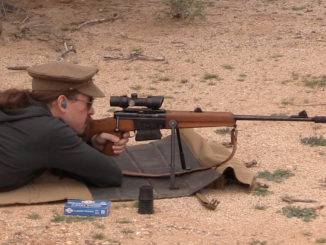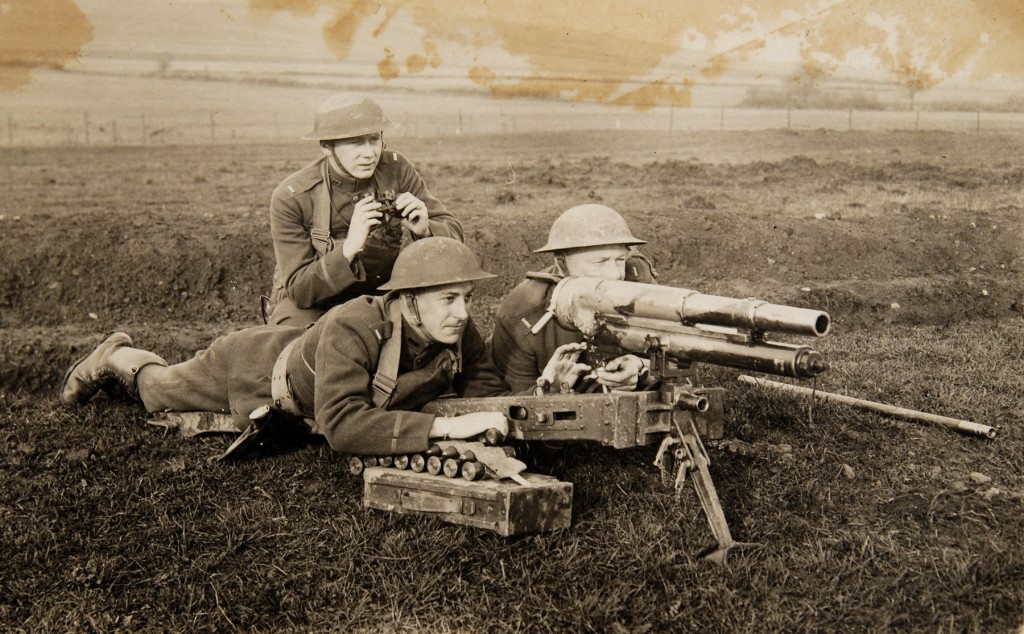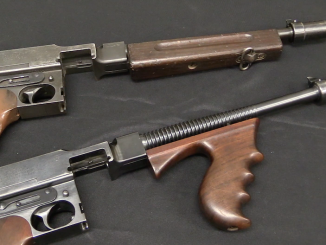Project Lightening is a collaborative series with Othais and Mae of C&Rsenal in which we test all seven light machine guns and automatic rifles of World War One and put them through a series of tests and evaluations. Each week we will be posting one video on Forgotten Weapons and one on C&Rsenal. Today we have the walking fire here, and the field strip assessment over on C&Rsenal:
Want to see the last two parts right now, instead of waiting until next week? You can download the entire series right now and have a permanent copy to keep for just $6 (all proceeds split between Forgotten Weapons and C&Rsenal):




Be glad we didn’t ask you to fire on the sprint instead!
Good news !
The website is back !
im sorry but Browning really showed the he should NEVER attempt to supply any kind of recommendation on HOW to use his weapons. Just goes to show you just because someone is a good engineer for a device doesn’t mean that they know how to properly use it.
Walking Fire has GOT to be the absolute worst battlefield strategy. Well, i guess second to the Japanese mindset of “we can’t lose, we are too proud”, ok yeah thats definitely the worst.
Fighting spirit will not save the day. Walking fire? I think making a mad dash whilst spraying the enemy position is far more intimidating (if impractical). Even worse than the Japanese banzai charge is the Napoleon-era two-rank volley on command if the engagement occurs during the trench-and-machine-gun era. Having your men stand around in a practically static formation and not take any form of cover makes a very good target for enemy field guns. Believe me, some armies were that stupid.
Not fair to JMB. This was a gun he designed to meet a demand, even if the unrealism of the demand was not realized until after production. Also not fair to test this without the “walking fire” belt pouch for the buttstock. Browning designed the best item for the customer’s stated wishes. Note that the many other firearms he designed were given practical shooting tests before he ever submitted the patents — from his first single-shot rifle to his last shotgun.
You’ve convinced me.
The BAR and Chauchat (both editions) were individual select-fire weapons.
The Madsen and Lewis were crew-served light machine guns and really need two people to operate them effectively.
The Maxim and Hotchkiss actually need a crew of three due to their feed systems and are more “heavy machine gun” that happens to be portable than they are “light” machine guns.
As company-level guns the 08/15 and Hotchkiss Portative were workable–and could be attached down to platoon level. Use them in a machine gun squad–but not as squad-level weapons. These two guns really need three operators–one to trip the trigger, one to pull the expended feed device through the gun, and one to shove new feed devices (belts or strips) through the gun. Another two to five men could haul the ammo, spare parts, and for the 08/15 extra water.
The Madsen and Lewis are on the light side for company-level machine guns but would be a blast at platoon level. They could even be the squad automatic weapon for the Great War French “rifle” squad, with its machine gun team and its rifle team. Two men, as noted, are required to operate these beasts even though you demonstrated that under range conditions one could make them go bang-bang. Having one or two more men to haul more ammo would be nice in addition to the two operators.
The three automatic rifles are individual weapons and for half-squads (or fire teams) are superior because they can be managed by a single operator. The USMC experimented with half-squads prior to 1940 in their many “small wars” and in the absence of a suitable semi-automatic rifle used either the BAR or a Thompson submachine gun as the base of fire for that element. A full squad of 9 Marines was found to be hard to maneuver in close terrain such as jungle or urban areas–but three to five Marines with one automatic weapon were nimble and responsive. By 1944–well after the Great War period–the Marines had a three fire team system, each team built around the BAR. Doing that with the Lewis or Madsen isn’t possible because instead of having all three to five Marines fighting, there’d be two on the gun and one or two or three more. Yes, the BAR was a handful, but a BAR-man had the same footprint as a rifleman and was almost as nimble. Having a squad of just BARs for automatic weapons isn’t bad when heavier weapons are available at higher echelons.
Too bad that Project Lightening can’t test modern GPMG, WWII LMG and present day Light Support Weapons and Squad Automatic Weapons under Great War conditions. You’re accomplishing a lot to bring those century-old weapons back to life.
Some of the tests would be better done with other weapons–such as firing the 100 yard test with the M1 Carbine or the Walking Fire with a trench shotgun loaded with #00 buckshot. About the 9-pellet #00 buckshot–the period standards weren’t putting all projectiles in the same six inch or three inch hole, getting one hit for every shot fired was “close enough for government work.” Applying target match standards to battlefield weapons may not be the best process for selecting battlefield weapons. Nineteenth Century testing of the Gatling gun versus a company of riflemen at a half mile range on a standard infantry target (100 feet wide by 6 feet tall strip of cloth) demonstrated that the Gatling put a greater percentage of its bullets on-target than did the expert riflemen.
Walking fire was eventually replaced by bounding overwatch–by one element firing from a hasty fighting position while another element maneuvered to its next firing position. Try having any three of those seven tested guns do that–two of you operating your chosen machine gun solo fire while the third moves up, and taking turns moving or shooting.
Good analysis, sir. There is also the problem of whether your infantry squad focuses on individual rifle marksmanship or whether it bunches around a general purpose machine gun between periods of movement…
“BAR and Chauchat (both editions) were individual select-fire weapons.”
Its worth to note that both could be called proto-assault-rifles, as trying to offer similar high volume of fire in packaging for single man. Most obvious difference is usage of full-power rifle cartridge, as at that time no-one responsible for weapons development was inclined toward adopting another cartridge, especially weaker one.
Also it should be note that both mentioned weapons were developed before sub-machine guns* were introduced [technically BAR should be 1917, but it was dubbed 1918 to avoid confusion with water-cooled machine gun using same cartridge].
* technically there was Italian Villar-Perosa but it was more like LMG firing pistol cartridge, rather than true sub-machine gun.
I think you should make your trench targets out of watermelon “people” I.e. Make them like you would a Bertie Bassett liquorice man, but with sharpened bamboo etc to life size scale, and all “spray them at once” walking in a line; if theres 3 liquorice men, and you reckon one of you is left; set on the remaining Pickelhaubed Bertie with a spiked trench club. To the following music:
https://youtu.be/_Rbj5i7QIXc
Then there would have been 3 Germans and 3 of you, now theres no Germans and one of you; do this for 4 years and win, after you.
So employ the Lewis wisely…
As in, if they have rifles. Throw grenades with your other hand; knives, rocks etc. This attack was beaten back; try harder, four years of this to fill. And millions of graves, do it again.
WITF you guys are not using carry straps with these guns in walking fire. And the tactic was just not for walking up to emplaced troops with machine guns. The intent was to allow these guns to be carried in the advance.
Both the Chauchats and BAR had special butt attachments on the belts to help stabilize the guns…why you are not using them I do not know, but it really is unfair to the guns.
This was still being taught in 1943, using the M1 rifle. The idea was to keep the heads down.
“Walking Fire” was another one of those concepts that looks great in theory, but which don’t work out so well in real life.
Your basic problem with this idea is that you simply can’t generate enough accurate volume of fire while moving to effectively keep the enemy from shooting back at you. The whole thing falls down on that fact alone, and it’s the reason why the far more effective technique of “fire and movement” came in, with mutually supporting teams moving in sequence, leap-frogging from fire position to fire position. The men who thought that “Walking Fire” would work were delusional in their conception of what it was like to conduct modern warfare; there is no way that real soldiers could possibly be accurate enough with any guns to actually suppress the enemy while on the move.
I have to point out that the set-up which Ian, Othais, and Mae used was laughably inaccurate in its depiction of the realities, here–The environment where “Walking Fire” would have been employed would have meant moving at least 100-150m minimum, between jumping-off point and the enemy positions. As well, with the way that the battlefields were torn up, being able to even identify where they needed to deliver their fire…? Far more difficult than the test range depicted here. Actual distances involved might have been more on the order of 200-300m, or even more, when you figure in the way that the Germans didn’t have fixed forward lines for the last half of the war…
The only way “Walking Fire” ever even got into general use was because the people who came up with and promulgated it across the armies didn’t ever have to do it, or observe what was really going on down on the firing lines. It’s a wonder that they didn’t kill even more soldiers than they did, as ass-backwards as they got things. The wonder to me is that they were still training this BS as late as 1942, and that it took actually meeting the Germans in the hedgerows of Normandy before they got this stupidity beaten out of their heads.
Y’know… I’m not even sure you could make “Walking Fire” work if you were going up against ranked rows of Civil War-era riflemen with black powder percussion rifles… I have the feeling that you’d probably miss most of your targets, and the return fire would probably force you to ground just as quickly as a German MG would.
Understand something about walking fire. For Infantry to advance they have to walk or run. In some situations, you have to get up and fire if you are in the advance. From a strategic situation over a battlefront, large number of troops are advancing most armed with rifles and they do not have heavy machine gun support. The idea of the Machine Rifle was to allow machine guns to advance with the troops and in some cases those troops needed to stand and fight, but not by themselves. Note the Chauchats had bipods…..this was an intent to let the soldier fall on the ground when shooting but NOT when attempting to advance along with his TEAM. Yes his team. Event the reloading was usually done by a team member when firing. An important part of the “walking fire” was that not only was the machine gun shooting but you had grenades and mortars being used in the advance. Yes the US troops suffered badly but it was generally their inexperience that got them in trouble. The BAR was a lighter weapon and the bipod did seem that useful even in WWII. What was useful was the butt cup in the belt AND the strap over the shoulder to not only make the weapon easier to carry but also for better fire control. For some reason, these three folks have decided from on high that the shoulder straps and belt cups were not important. They appear to have also forgotten to put the 8 pound of water that was in Mg 08’s water jacket with the steam port in the off position and I doubt if they have increased the weight of the Mg 08/15s drum mag to hold 100 rounds. However they did get the MG 08/15’s bipod turned the right way for walking fire, unfortunately, they failed to turn the bipod around for prone fire with the MG 08/15, a mistake that failed to redistribute the guns center of gravity for ground fire (and also didn’t have the water in the gun–or perhaps an external counter weight. The 8 pounds of water would help hold down the gun…..a nice project, but darn, even if using modern straps instead of the original would have created a more fair comparison. Even a rope. I own built parts kits or “replicas” of these guns (mg 08/15 (converted to gas gun), 1909 Portative, CSRG 1915 and 1918, BAR (actually an all metal Ohio Airsoft converted to WWI with an original BAR forestock, Madsen…missing the Lewis but a friend has one of the expensive parts kits guns) and can attest that when I demonstrate (or allow visitors to handle) walking with the weapons, the straps are a MAJOR benefit. I think that these folks ought to do a video addressing these concerns for the comparative benefit. I guess I could do my own Youtube video….have some events coming up, need to suit up I guess for some video but I would rather seen these folks do it with live fire.
I’ve yet to find an actual corroborated historical account where “Walking Fire” actually, y’know… Worked.
Lots and lots of people discussing it in terms of training and theory, yet I’ve never seen anyone who described it working, and who survived attempting it. The whole thing is ludicrous, when you think about it–Firing on every step while moving at a walking pace? WTF? First off, you need to be doing the classic 3-to-5 second rush between positions, or as we well know from modern combat, you’re gonna get identified and then hit.
I don’t care how logical and carefully worked out the theory was, the reality is that what they were doing was sheer organized suicide, and there’s no way it would have ever worked effectively in combat. The theory is unworkable, always has been–And, I’m not even sure that were you to somehow put WWI-era infantry up against Civil War-era infantry, with all that entails, that it would have been any more workable.
“Walking Fire” is just another in a long line of idiotic theories that came out of the headquarters and which simply didn’t work, at all. The reason you don’t find too many accounts of it working in the historical references that actually include first-person accounts and descriptions of actions? The men who trusted their leaders and actually tried this stupid shit died–Which is why nobody writes about it ever working.